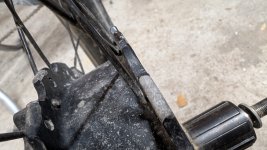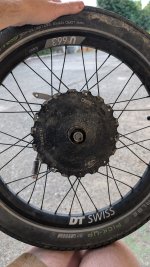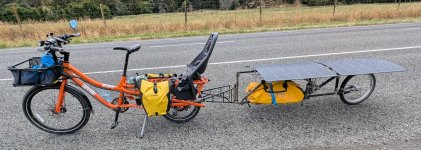Hi all,
I have a Yuba Sweet Curry longtail cargo bike. It has a 20" rear and 26" front wheel. I converted it with a GMAC (taken from another bike) in the rear wheel, laced into a DT Swiss U 663 rim and Sapim Strong single butted spokes (13g-14g; 115mm long as per Grin spoke calculator). It's laced in a single cross pattern with elbows inside on the drive side, and elbows outside on non-drive-side (this seemed to be the most common for 20" GMAC cargo bike builds in Grin's gallery). The wheel was built for me by a local bike mechanic who has lots of experience building wheels, but not much with hub motors (they're not very popular around here! everyone buys pre-built mid drives). He did comment at the time that he thought the spokes were a couple mm longer than ideal and did have to manhandle them a bit to build the wheel up. So there's a slight bend in them - visible in pics. Plucking the spokes results in a ~high soprano tone (I don't have a tension gauge and the spoke are too short to get a TM-1 or similar on there anyway). The wheel has ~1400km total on it.
I recently did a 500km tour with this bike towing my solar trailer (build thread if interested, though I owe you all an update!). I had my 18 month old + panniers on the back, and the trailer was probably 30kg. Plus me at ~90kg and the total system weight is probably 180-190kg. It was on the Alps2Ocean cycle trail plus some back roads. The terrain was mostly pavement or shingle roads/bike tracks, but there was ~30km of kinda rocky terrain at the limit of what I'd do on a cargo bike (included a couple pics showing worst terrain). When I got home, there were 5 broken spokes. I didn't notice them on the trip because they remained wedged up against the hub flange so made no noise. The spokes were all broken at the hub end, all on the drive side, and all were the "outermost" spokes in the pattern (not sure how to describe that, but you'll see what I mean in the pics).
I really like the bike + GMAC system as it's a hill climbing beast with great regen. So I'm keen to rebuild the wheel and make this work. Other than using slightly shorter spokes this time (I was thinking 113mm), does anyone have any advice for what I could do to make this wheel stronger when rebuilt?
Should it have all elbows out, or perhaps in an over-under pattern on the drive side? Grin's wheel building page mentions that if spokes are not snug against the hub flange, that can be a cause of spoke breakage. This is the case in my wheel on the drive side (see pics - visible gap between spoke and hub flange on drive side, but spokes are snug on non-drive-side). Though when lacing with elbows inside, isn't there inevitably going to be a gap between the straight part of the spoke and the hub flange? Yet it's common to build hub motor wheels with elbows inside, and even required for the All-Axle motor. So I'm missing something here.
Should I source and use a rim with angled spoke holes? So that the spokes don't have to bend so much (calc says spoke angle is 75°, not ideal). Maybe a Ryde Andra 40? I'd have to order one of those from Europe and I have no other use for the U 663 so that's not ideal, but if it'll result in a meaningfully stronger wheel then so be it.
Thanks in advance for any suggestions!
I have a Yuba Sweet Curry longtail cargo bike. It has a 20" rear and 26" front wheel. I converted it with a GMAC (taken from another bike) in the rear wheel, laced into a DT Swiss U 663 rim and Sapim Strong single butted spokes (13g-14g; 115mm long as per Grin spoke calculator). It's laced in a single cross pattern with elbows inside on the drive side, and elbows outside on non-drive-side (this seemed to be the most common for 20" GMAC cargo bike builds in Grin's gallery). The wheel was built for me by a local bike mechanic who has lots of experience building wheels, but not much with hub motors (they're not very popular around here! everyone buys pre-built mid drives). He did comment at the time that he thought the spokes were a couple mm longer than ideal and did have to manhandle them a bit to build the wheel up. So there's a slight bend in them - visible in pics. Plucking the spokes results in a ~high soprano tone (I don't have a tension gauge and the spoke are too short to get a TM-1 or similar on there anyway). The wheel has ~1400km total on it.
I recently did a 500km tour with this bike towing my solar trailer (build thread if interested, though I owe you all an update!). I had my 18 month old + panniers on the back, and the trailer was probably 30kg. Plus me at ~90kg and the total system weight is probably 180-190kg. It was on the Alps2Ocean cycle trail plus some back roads. The terrain was mostly pavement or shingle roads/bike tracks, but there was ~30km of kinda rocky terrain at the limit of what I'd do on a cargo bike (included a couple pics showing worst terrain). When I got home, there were 5 broken spokes. I didn't notice them on the trip because they remained wedged up against the hub flange so made no noise. The spokes were all broken at the hub end, all on the drive side, and all were the "outermost" spokes in the pattern (not sure how to describe that, but you'll see what I mean in the pics).
I really like the bike + GMAC system as it's a hill climbing beast with great regen. So I'm keen to rebuild the wheel and make this work. Other than using slightly shorter spokes this time (I was thinking 113mm), does anyone have any advice for what I could do to make this wheel stronger when rebuilt?
Should it have all elbows out, or perhaps in an over-under pattern on the drive side? Grin's wheel building page mentions that if spokes are not snug against the hub flange, that can be a cause of spoke breakage. This is the case in my wheel on the drive side (see pics - visible gap between spoke and hub flange on drive side, but spokes are snug on non-drive-side). Though when lacing with elbows inside, isn't there inevitably going to be a gap between the straight part of the spoke and the hub flange? Yet it's common to build hub motor wheels with elbows inside, and even required for the All-Axle motor. So I'm missing something here.
Should I source and use a rim with angled spoke holes? So that the spokes don't have to bend so much (calc says spoke angle is 75°, not ideal). Maybe a Ryde Andra 40? I'd have to order one of those from Europe and I have no other use for the U 663 so that's not ideal, but if it'll result in a meaningfully stronger wheel then so be it.
Thanks in advance for any suggestions!
Attachments
-
 PXL_20250218_071158031.jpg1.7 MB · Views: 18
PXL_20250218_071158031.jpg1.7 MB · Views: 18 -
 PXL_20250206_012611667.jpg3.9 MB · Views: 20
PXL_20250206_012611667.jpg3.9 MB · Views: 20 -
 PXL_20250204_235404466.jpg5.2 MB · Views: 24
PXL_20250204_235404466.jpg5.2 MB · Views: 24 -
 PXL_20250212_070320183.jpg2.3 MB · Views: 28
PXL_20250212_070320183.jpg2.3 MB · Views: 28 -
 PXL_20250212_070325200.jpg1.8 MB · Views: 27
PXL_20250212_070325200.jpg1.8 MB · Views: 27 -
 PXL_20250104_010917434~2.jpg1.4 MB · Views: 24
PXL_20250104_010917434~2.jpg1.4 MB · Views: 24 -
 PXL_20250218_071134246.jpg1.7 MB · Views: 19
PXL_20250218_071134246.jpg1.7 MB · Views: 19




